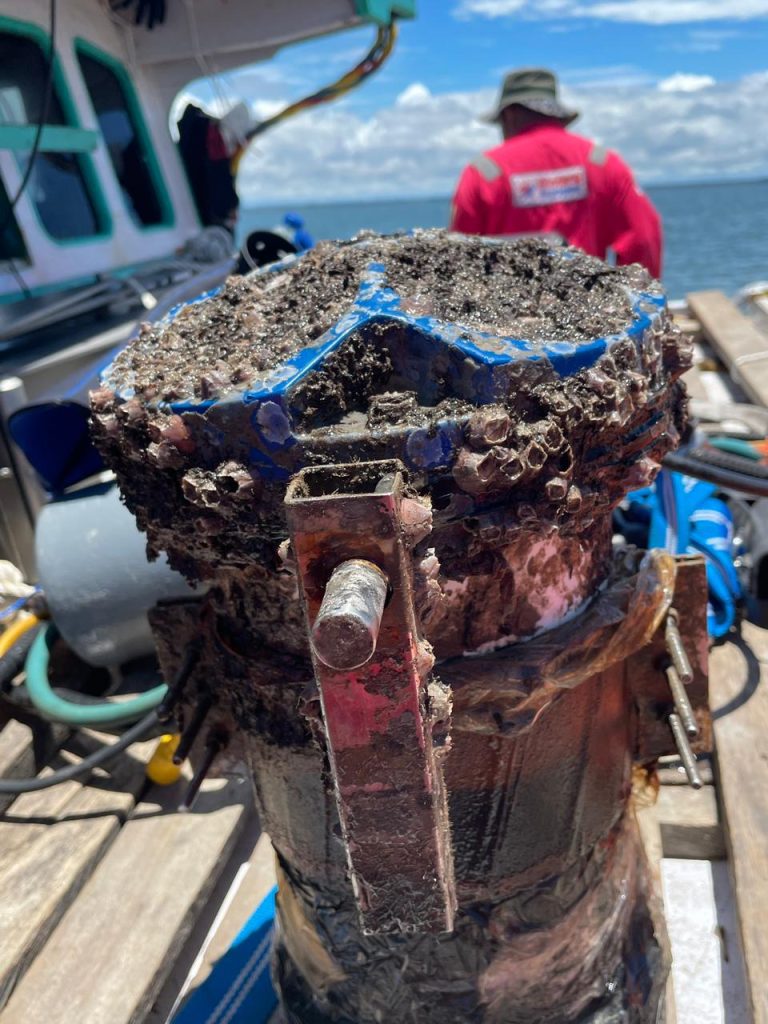Biofouling: An Inevitable Silent Threat in Ocean Measurement
(AF | 04/01/2024)
In the scope of ocean in-situ measurements, biofouling emerges as a challenging threat. One of our partners has experienced this while taking measurements in the waters of Timika, Papua, Indonesia . Over three months of observation, they encountered a significant challenge: more than 20% of the Acoustic Doppler Current Profilers (ADCP) used for measurement were covered with barnacles and other organisms, resulting in a failure of the measurement process and subsequent data loss (Figure 1). This phenomenon is commonly known as biofouling.

Figure 1. Biofouling on ADCP measurement device after three months of deployment in Timika, Papua (Source: PT Bintang Subsea Indonesia)
Understanding Biofouling
Biofouling, or biological fouling, manifests as the accumulation of microorganisms, plants, algae, or small animals on wet surfaces, causing structural or functional deficiencies. It progresses through two main stages: microfouling, involving biofilm formation on surfaces, and macrofouling, characterized by the attachment of organisms like barnacles and seaweed, forming a fouling community.
Raymond (2023) identifies four key phases of biofouling: submersion of structures, absorption of organic carbon from seawater, colonization by diatoms and bacteria, followed by biofilm formation, and, lastly, the arrival of larger marine organisms initiating macrofouling.
Biofouling in Indonesian Waters
The growth rate of biofouling can vary significantly in different climate waters, and several factors contribute to these variations. Some of these factors include seawater temperature, nutrient presence, salinity, sunlight exposure, substrate type, water flow dynamics, etc.
Indonesian waters have a tropical climate with ample sunshine throughout the year and consistently warm temperatures. Indonesian waters are also known to be rich in nutrients, caused by factors such as river discharge and ocean currents. Warm waters and abundant nutrient contribute to faster biofouling growth rates. Understanding these factors is crucial for developing effective biofouling management strategies in Indonesian waters.
Challenges in Indonesian Metocean Industries
Biofouling becomes problematic for measurement devices, ocean buoys, and buoy moorings, potentially blocking sensors and disrupting the measurement process. This issue escalates for long-term measurements or permanent structures, necessitating costly routine cleaning and significant investment in repair and maintenance.
Illustratively, in Timika, Papua, an ADCP used for three months exhibited macrofouling, impeding acoustic signals and compromising velocity data. Consequently, the water velocity data was either lost entirely or returned as highly noisy, caused a failure in deriving the wave direction data. These examples provide a glimpse of the challenges posed by biofouling to in-situ measurements in Indonesian waters.
Ideal Solutions to Overcome Biofouling
Microfouling can be addressed by scrubbing affected surfaces and washing instruments with fresh water. However, one must be careful in performing this cleaning as there is a risk of damaging the sensitive parts of the measurement instrument sensors. Meanwhile, macrofouling requires more comprehensive treatment.
Various preventive methods are under development. According to Sasongko (2008), surfaces with dark colours (brown, green, black, and red) are preferred by fouling organisms compared to light colours (yellow, orange, and white). While Marhaeni (2012) suggests solid textured substrates with smooth surfaces and light colors. Antifouling methods, such as bio dispersants, coatings, thermal treatments, or energy pulses, can be used to prevent colonizer accumulation.
As mentioned by Raymond (2023), the entire process of biofouling accumulation can occur in as little as three weeks. Therefore, at least a monthly regular maintenance is recommended for metocean measurement instruments, considering the rapidity of biofouling accumulation in Indonesia’s nutrient-rich tropical waters.
Conclusion
Biofouling is a major threat to the metocean industry, threatening the quality of data collected from ocean observations. To maintain the integrity of in-situ measurements, pro-active approaches are recommended, starting with a comprehensive design to prevent the occurrence of biofouling, and follow-up measures such as monthly routine maintenance to maintain the condition of the observation instruments. However, it is crucial to carefully choose biofouling prevention and mitigation methods to avoid accidental damage to these instrument components and the environment.
References
[1] Marhaeni, B. (2012). Biofouling pada beberapa jenis substrat permukaan kasar dan halus. Sains Akuatik: Jurnal Ilmiah Ilmu-Ilmu Perairan, 14(1).
[2] Raymond, N. (2023). What is Biofouling and How Can We Stop It?. Sofar Ocean. [Online] accessed on 13 November 2023. https://www.sofarocean.com/posts/what-is-biofouling-and-how-can-we-stop-it.
[3] Sasongko, S. (2008). Pengaruh warna cat anti corrosion (AC) terhadap penempelan Vortec pada bagian badan kapal. Undergraduate Theses Teknik Perkapalan Ekstensi. Institut Teknologi Surabaya.
[4] Wikipedia contributors. (2023). Biofouling. Wikipedia: The Free Encyclopedia. [Online] accessed on 13 November 2023. https://en.wikipedia.org/w/index.php?title=Biofouling&oldid=1181900493.
[5] Yusim, A. K. (2016). Studi Eksperimental Pengaruh Pertumbuhan Biofouling pada Lambung Kapal terhadap Skin Friction Drag. (Magister Thesis) Program Studi Teknik Produksi Dan Material Kelautan: Institut Teknologi Sepuluh Nopember, Surabaya.